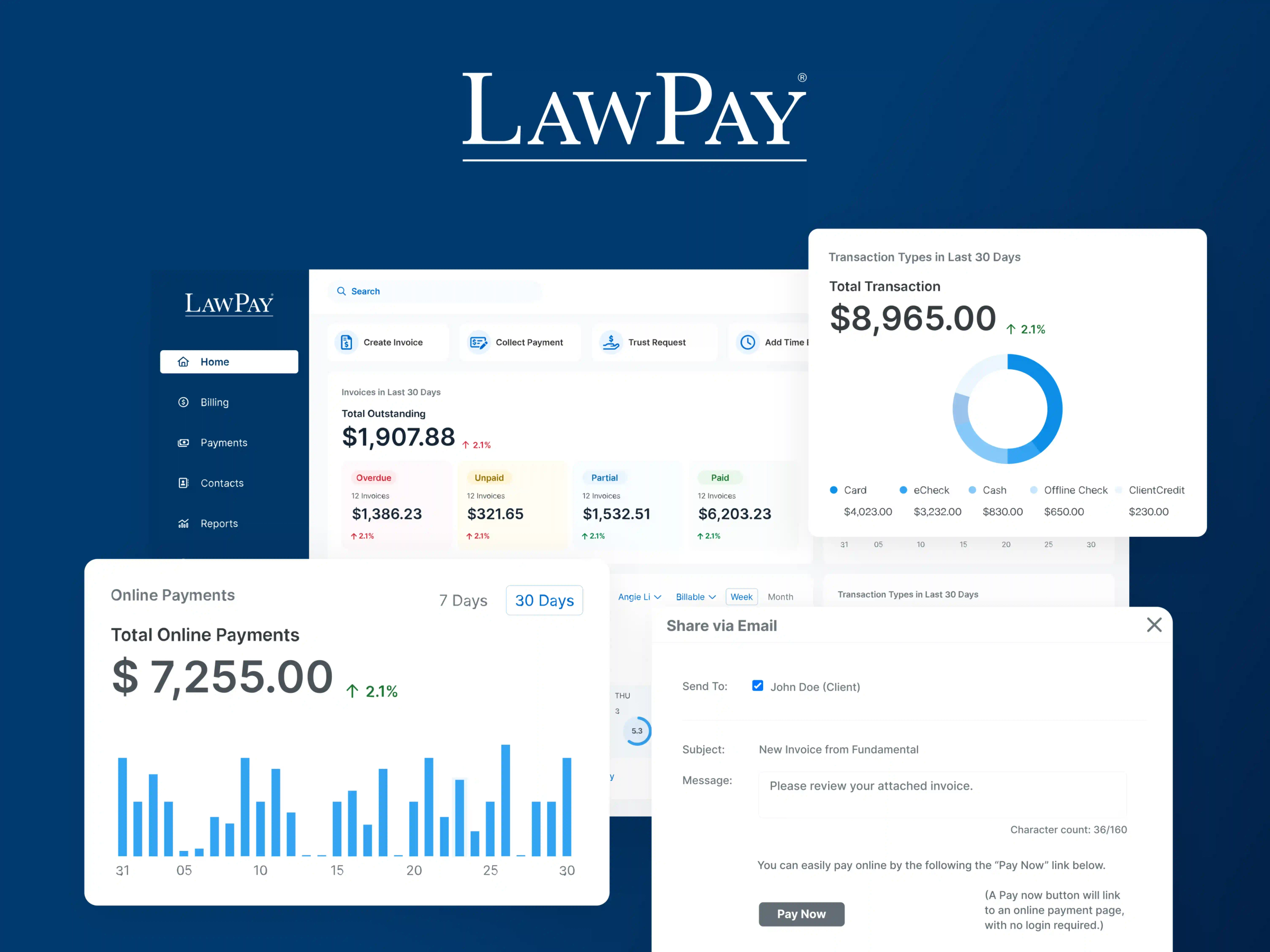Your law firm chart of accounts is the backbone of your accounting system. It lists and categorizes all your firm's financial accounts. This listing also provides a structure for correctly managing funds between operating accounts and pooled trust accounts.
Law firms have unique accounting needs. For example, you must track pooled trust account balances by client, and you cannot commingle operational funds and client funds. Addressing those compliance issues requires a proper, lawyer-specific chart of accounts. Generically designed systems allow mistakes to be made too easily.
Schedule a demo to see what LawPay can offer your firm.
Get a demo
Read on to learn how to anchor your accounting system with a solid chart of accounts. We'll cover the role the chart of accounts plays in your firm, its components, a sample template, and tips on correctly setting up a legal chart of accounts.
What Is a Law Firm Chart of Accounts? A law firm chart of accounts lists your firm's general ledger accounts. These are the line items on the firm's balance sheet and income statement. At the highest level, the chart of accounts consists of assets, liabilities, equity accounts, revenues, and expenses:
Assets are items your company owns and will use to create value in the future. Two main asset types are current assets and fixed assets. Current assets are cash or items you expect to convert into cash within one year. Fixed assets are intended for long-term use and are subject to depreciation.
Liabilities are your law firm's debts. Current liabilities are payable within 12 months. Long-term liabilities are not due within the next year.
Equity accounts show the composition of the firm's ownership.
Revenue accounts represent the ways a firm receives cash or generates accounts receivable.
Expense accounts define where the firm spends money in the creation of income.
Your firm's various financial accounts are organized under these categories. For example, your asset account might contain sub-accounts for your operating bank account, accounts receivable, and advanced client costs. Your liability account will have sub-accounts for current, segregated, and long-term liabilities. Nested under these you would find business credit card accounts, pooled trust accounts, and bank loans, among other things.
Why is Creating a Chart of Accounts Important? Organizing the structure of your financial accounts into a chart of accounts enables your firm to record transactions properly. That structure is essential for tracking account balances, producing correct income and balance statements, and maintaining proper documentation for your law firm’s tax deductions.
Specific to law firms, a workable chart of accounts helps you keep trust funds and operating funds separate. It also allows for the organization and documentation of advanced client costs so that the firm can bill for them.
What Are the Components of a Chart of Accounts? The most basic component of the chart of accounts is the chart itself, which is a categorized list of your accounts. The chart enables transaction records for each account. And the transaction records feed into the firm's balance sheet and income statement.
List of Accounts The list of accounts is a hierarchical outline of the firm's financial accounts, grouped at the top level by assets, liabilities, equity accounts, revenue, and expenses. Your firm's chart of accounts will have several sub-accounts under each of the top-level groups, often with their own sub-accounts.
An example specific to law firms would be the sub-account of segregated liabilities. Under the heading of segregated liabilities, your chart of accounts should include pooled trust accounts and separate, interest-bearing trust accounts.
Records for Each Account As noted, a proper chart of accounts facilitates the appropriate recording of the transactions within those accounts. Following law firm accounting best practices, each transaction requires a debit from one account and a credit to another.
This double-entry system arises from a basic accounting equation: Assets equals liabilities plus equities. An increase in asset and expense accounts is a debit, while an increase in credit, equity, and revenue accounts is a credit. Your law firm's accounting software enforces double-entry recording -- and your chart of accounts enables it.
The payment of a simple utility bill demonstrates this process in action. When you pay the bill, your cash account balance decreases and your utility expenses rise. You'd record that as a credit to cash, an asset sub-account, and a debit to utility expense, an expense sub-account. If your firm pays that bill with a credit card instead, the transaction would involve a credit to the credit card account on the liability side, plus a debit to utility expense.
If your chart of accounts is not set up correctly, your transactions will not balance and the records for each account could be inaccurate.
Balance Sheet and Income Statement The transaction records roll up to create your firm's financial statements. The balance sheet shows your firm's asset, liability, and equity balances as of a given day. The income statement shows your firm's aggregate revenues and expenses over a specified timeframe.
Together, these statements show how your law firm is performing financially. The balance sheet documents how the firm is funding business operations between debt and equity. It also shows how the firm's assets compare to its liabilities. From that data, you can calculate various liquidity metrics -- with the goal of understanding how well your firm can meet its financial obligations.
The income statement records the firm's profitability. If the firm is not profitable or barely profitable, you could use the income statement to help identify what changes should be made.
Chart of Accounts Sample A sample chart of accounts generally shouldn't be copied directly into your law firm accounting software without some customization. Your firm will likely need more, fewer, or different accounts. However, you can use the sample below as a starting point.
Assets
Account Code | Account Name |
100 | Checking account |
102 | Savings account |
105 | Petty Cash |
120 | Cliend advances, unbilled |
125 | Client advances, billed |
130 | Accounts receivable |
140 | Prepaid expenses |
150 | Furniture and equipment |
160 | Real estate |
170 | Accumulated depreciation |
180 | Other assets |
Liabilities
Account Code | Account Name |
200 | Accounts payable |
210 | Business credit card |
220 | Federal income tax payable |
221 | State income tax payable |
222 | FICA taxes payable |
230 | Employee meidcal payable |
Segregates Liabilities
Account Code | Account Name |
298 | Client trust funds |
299 | Trust fund interest payable |
Owners Equity
Account Code | Account Name |
300 | Owners equity |
301 | Owners draws |
Income
Account Code | Account Name |
400 | Fee income |
420 | Interest income |
430 | Other income |
Expenses
Account Code | Account Name |
500 | Administrative staff compensation |
505 | Lawyer compensation |
510 | Other non-owner employee compensation |
520 | FICA and unemployment rates |
523 | Employee retirement benefits |
525 | Employee training |
529 | Other employee costs |
530 | Rent |
533 | Parking |
535 | Real estate taxes and insurance |
537 | Utilities |
539 | Office repairs |
550 | Office supllies |
552 | Postage |
555 | Telephone expenses |
557 | Office equipment |
560 | Depreciation expense |
570 | Travel expense |
575 | Professional dues |
577 | Recruiting expense |
580 | Entertainment |
585 | Marketing and advertising |
590 | Insurance |
600 | Other expenses |
605 | Bad debt expense |
Another resource to check is the State Bar of Georgia’s sample chart of accounts for lawyers. Reference it as a guide and adjust as needed to reflect your firm's financial situation.
How Do You Set Up a Chart of Accounts for Your Law Firm? To set up an accounting system that supports compliant financial management, you need specialized tools and applications. You can modify the chart of accounts in a generic accounting platform like Quickbooks Online. But, you'll likely need integrated, lawyer-specific tools to manage and reconcile client advances and trust accounts.
To start, make sure your chart of accounts includes the following:
a pooled trust liability account
sub-accounts for client-specific trust balances
a trust interest payable account
client advance accounts
You may need other modifications as well.
As a next step, take stock of any software that integrates with your accounting application. This includes case management, payments, and billing programs. If you are logging time and reimbursable expenses or creating invoices in an application, that program affects the records organized under your chart of accounts.
Again, it's ideal to use software that's designed for lawyers. That way, the software's capabilities align with law firms' unique accounting challenges. Specifically, your firm needs software that can properly handle retainer funds, from the initial deposit through the transfer of earned funds into the operating account.
As an example, LawPay, an online payment platform built for lawyers, automatically enforces the separation of business and client funds throughout the billing and collection process. A common mistake that arises with generic payment solutions is charging credit card fees to trust accounts. This won't happen when you accept payments through LawPay -- the system only applies fees and chargebacks to your firm's operating account. That's just one feature of several that help you avoid inadvertent ethics violations.
Proper transaction recording has other benefits, too. The information you use to make business decisions -- such as financial statements and a legal KPIs dashboard -- will be more accurate. Your decisions will be more effective as a result.
Case management software, like MyCase, is another example. Attorneys use the application to record billable and nonbillable time and expenses. The billable data flows automatically into client invoices. Non billable entries flow into the reporting, so you can monitor and manage them.
Both LawPay and MyCase support specialized law firm reporting. LawPay generates transaction details and daily deposits of client funds. MyCase provides trust account reports so you can reconcile your firm's trust retainer accounts -- and remain compliant with state law.
Final Notes Your law firm's chart of accounts must support accurate and compliant transaction reporting. At a minimum, your listing of financial accounts will include a pooled trust account as a segregated liability, with sub-accounts to track client retainer balances. You will also need accounts to track reimbursable expenses or advanced client costs.
Schedule a demo to see what LawPay can offer your firm.
Get a demo
Once you create an appropriate chart of accounts, your firm needs a complete system for logging time, expenses, and client funds into those accounts. That includes the separation of collected retainers and the proper transfer of earned retainers into the firm's operating account.
LawPay and MyCase, together, streamline the processes for tracking time and expenses, invoicing, and collecting client payments. Both applications support compliant financial management for lawyers. Both are also approved by more than 50 bar associations.
Complete and compliant accounting produces more accurate financial statements. In turn, you can make better decisions about optimizing your firm's operations and profitability. See how we can help by talking to our team of Certified Payment Specialists today.
About the author

Catherine BrockContent Writer
Catherine Brock is a Content Writer for leading legal software companies, including MyCase, Docketwise, CPACharge, CASEpeer, and LawPay—the #1 legal payment processor. She covers emerging legal technology, financial wellness for law firms, the latest industry trends, and more.
